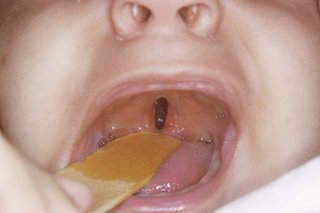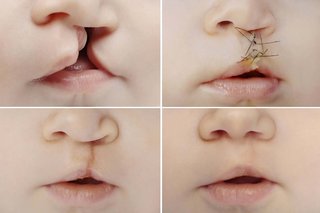A cleft is a gap or split in the upper lip and/or roof of the mouth (palate). It is present from birth.
The gap is there because parts of the baby's face did not join together properly during development in the womb.
What does a cleft lip and palate look like?
Babies can be born with a cleft lip, a cleft palate, or both.
A cleft lip may just affect one side of the lip or there may be 2 clefts.

It can range from a small notch to a wide gap that reaches the nose.
A cleft palate may just be an opening at the back of the mouth, or it may be a split in the palate that runs all the way to the front of the mouth.

Sometimes it can be hidden by the lining of the roof of the mouth.
Problems related to cleft lip and palate
A cleft lip and cleft palate can cause a number of issues, particularly in the first few months after birth, before surgery is done.
Problems can include:
- difficulty feeding – a baby with a cleft lip and palate may be unable to breastfeed or feed from a normal bottle because they cannot form a good seal with their mouth
- hearing problems – some babies with a cleft palate are more vulnerable to ear infections and a build-up of fluid in their ears (glue ear), which may affect their hearing
- dental problems – a cleft lip and palate can mean a child's teeth do not develop correctly and they may be at a higher risk of tooth decay
- speech problems – if a cleft palate is not repaired, it can lead to speech problems such as unclear or nasal-sounding speech when a child is older
Most of these problems will improve after surgery and with treatments such as speech and language therapy.
Causes of cleft lip and palate
A cleft lip or palate happens when the structures that form the upper lip or palate fail to join together when a baby is developing in the womb.
The exact reason why this happens to some babies is often unclear. It's very unlikely to have been caused by anything you did or did not do during pregnancy.
In a few cases, cleft lip and palate is associated with:
- the genes a child inherits from their parents (although most cases are a one-off)
- smoking in pregnancy or drinking alcohol while pregnant
- obesity during pregnancy
- a lack of folic acid during pregnancy
- taking certain medicines in early pregnancy, such as some anti-seizure medicines
In some cases, a cleft lip or palate can occur as part of a condition that causes a wider range of birth defects, such as 22q11 deletion syndrome (sometimes called DiGeorge or velocardiofacial syndrome) and Pierre Robin sequence.
The Cleft Lip and Palate Association has more information on Pierre Robin sequence
Diagnosing cleft lip and palate
A cleft lip is usually picked up during the 20-week screening scan done when you're between 18 and 21 weeks pregnant. Not all cleft lips will be obvious on this scan and it's very difficult to detect a cleft palate on an ultrasound scan.
If a cleft lip or palate does not show up on the scan, it's usually diagnosed immediately after birth or during the newborn physical examination done within 72 hours of birth.
When a cleft lip or palate is diagnosed, you'll be referred to a specialist NHS cleft team who will explain your child's condition, discuss the treatments they need and answer any questions you have.
You may also find it useful to contact a support group, such as the Cleft Lip and Palate Association, who can offer advice and put you in touch with parents in a similar situation.
Treatments for cleft lip and palate
Cleft lip and cleft palate are treated at specialist NHS cleft centres.
Your child will usually have a long-term care plan that outlines the treatments and assessments they'll need as they grow up.
The main treatments are:
- surgery – an operation to correct a cleft lip is usually done when your baby is 3 to 6 months and an operation to repair a cleft palate is usually done at 6 to 12 months
- feeding support – you may need advice about positioning your baby on your breast to help them feed, or you might need to feed them using a special type of bottle
- monitoring hearing – a baby born with cleft palate has a higher chance of glue ear, which may affect hearing. Close monitoring of their hearing is important and if glue ear affects their hearing significantly, a hearing aid may be fitted or small tubes called grommets may be placed in their ears to drain the fluid
- speech and language therapy – a speech and language therapist will monitor your child's speech and language development throughout their childhood and help with any speech and language problems
- good dental hygiene and orthodontic treatment – you'll be given advice about looking after your child's teeth, and they may need braces if their adult teeth don't come through properly
Outlook for cleft lip and palate
The majority of children treated for cleft lip or palate grow up to have completely normal lives.
Most affected children will not have any other serious medical problems and treatment can usually improve the appearance of the face and problems with feeding and speech.
Surgery to repair a cleft lip may leave a small pink scar above the lips. This will fade over time and become less noticeable as your child gets older.

Will a cleft lip and palate happen again?
Most cases of cleft lip or palate are a one-off and it's unlikely you'll have another child with the condition.
The risk of having a child with a cleft lip or palate is slightly increased if you've had a child with the condition before, but the chances of this happening are thought to be around 2 to 8%.
If either you or your partner were born with a cleft lip or palate, your chance of having a baby with a cleft is also around 2 to 8%.
The chances of another child being born with a cleft or of a parent passing the condition to their child can be higher in cases related to a genetic condition.
For example, a parent with 22q11 deletion syndrome (DiGeorge syndrome) has a 1 in 2 chance of passing the condition to their child.
Information about your child
If your child has a cleft lip or palate, your cleft team will pass information about them to the National Congenital Anomaly and Rare Disease Registration Service (NCARDRS).
This helps scientists look for better ways to prevent and treat this condition. You can opt out of the register at any time.
Page last reviewed: 23 March 2023
Next review due: 23 March 2026